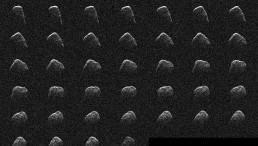![Colorado River Toad Releases Psychedelic Compounds That Could Treat Depression, Anxiety [Study] Colorado River Toad Releases Psychedelic Compounds That Could Treat Depression, Anxiety [Study]](https://1721181113.rsc.cdn77.org/data/images/full/53533/colorado-river-toad-releases-psychedelic-compounds-that-could-treat-depression-anxiety-study.jpeg?w=820)
(Photo : Wikimedia Commons/kuhnmi)
Colorado River Toads have the potential to help treat depression and anxiety. Researchers have learned that they secrete psychedelic compounds that could improve mental conditions.
Colorado River Toads' Psychedelic Compounds For Anxiety and Depression
Colorado River Toads (Incilius alvarius) have skin glands that emit a psychedelic substance similar to the drug dimethyltryptamine (DMT) when they are scared. Psilocybin, a hallucinogen found in "magic mushrooms," and DMT are similar in structure and effects.
Colorado River Toads are found in and around the Sonoran desert, which spans parts of Arizona, California, and Mexico. People looking for the venom's heady effects can either lick the toads directly or extract the venom, dry it, and smoke it.
In a new study, researchers at New York's Mount Sinai Hospital looked into the possible health advantages of toad secretions. Although it's known that psychedelics like psilocybin can assist in alleviating depression in some instances, its exact mechanism of action is yet unknown. On the other hand, it seems to work with serotonin receptors and reset brain circuit activity.
The majority of studies on psychedelics have looked at how the drug affects 5-HT2A serotonin receptors, a specific type of serotonin receptor. However, the researchers behind the new research concentrated on a less well-known serotonin receptor termed 5-HT1A, which is thought to interact with the toad toxin based on previous research.
The toad-derived substance's hallucinatory effects were abolished when the researchers chemically modified it to signal the 5-HT1A receptors. The mice who showed signs of stress and depression were then given the compound.
It was discovered that mice given the chemical drank more sweetened sugar water and interacted with their peers more frequently, both of which are indicators of reduced anxiety and despair. Similar outcomes have been observed in patients given LSD or psilocybin treatments.
"Frankly, that's what we hope to see," said Audrey Warren at Mount Sinai Hospital.
The substance may have therapeutic potential in humans, as humans and other animals have similar brain receptors. Warren and her team hope that in the future, someone may use their study's results to aid in the development of innovative antidepressants. However, Warren believes that's a long way off.
She also advises against smoking the poison or licking Colorado River Toads till then. Seizures, anxiety, vomiting, and even death are possible side effects, in addition to severe hallucinations.
ALSO READ: Goliath Frogs About the Size of Domestic Cats Are Endangered Due To Overhunting, Pet Trade [Report]
What Is Colorado River Toad?
Colorado River Toad is the most enormous toad in the West, measuring 4-7.5 inches. It has a smooth, creamy-white underbelly and a dark olive-green, leathery skin above. It is hefty and has short legs. It has an enlarged white wart close to the jaw's angle and noticeable cranial crests.
The necks of males and females are both pale. It has no vocal sac or a vestige of one. It sounds like a low-pitched whistling from a ferryboat.
These toads can be found in various habitats, including creosote bush ( a desert scrub), grasslands, oak-pine woodlands, thorn scrub, and tropical deciduous forests. They are carnivorous, and their diet includes insects, spiders, beetles, grasshoppers, lizards, rodents, and other toads.
Colorado River Toads are nocturnal. They spend the hottest part of the day underground. Rainfall stimulates activity, although it is not necessary for breeding.
They are most active in May and July. Throughout the winter, they hibernate underground in burrows. Usually, breeding takes place in the spring and summer. Compared to other toad species, Colorado River Toads are more aquatic
RELATED ARTICLE: Two New Species of Endangered Glass Frogs With See-Through Bodies Discovered in Active Mining Sites in Ecuador
Check out more news and information on Frogs in Science Times.










![Mars Faces Three Times More Potentially Hazardous Asteroids Than Earth [Study]](https://1721181113.rsc.cdn77.org/data/thumbs/full/53711/258/146/50/40/mars-faces-three-times-more-potentially-hazardous-asteroids-than-earth-study.jpeg)



